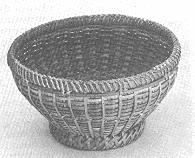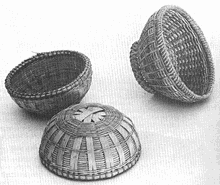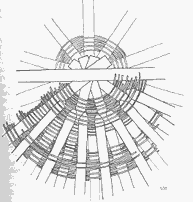Small Baskets for Other Functions
| Several
types of small baskets are made from bamboo, each intended for a specific function an
woven in an appropriate form. Some of these are for containing puffed rice which is eaten
directly from the basket, some are measures for rice, while others are to collect and
store flowers.
 This is a small semi-spherical basket woven form split-cane
elements. The basket’s semi-spherical form rests on a circular hand attached to the
base. The diameter of the basket is 200 mm and its depth is 100 mm. The ring-like band at
the base is 15 mm wide and 110 mm in diameter.
Structure This is a small semi-spherical basket woven form split-cane
elements. The basket’s semi-spherical form rests on a circular hand attached to the
base. The diameter of the basket is 200 mm and its depth is 100 mm. The ring-like band at
the base is 15 mm wide and 110 mm in diameter.
Structure
The main warp elements overlap and radiate from the centre of the base, up the sides of the basket. The weft is a single element which is first taken parallel to one of the main warp elements, before being bent sharply to start spiralling around the centre of the base and interlace the warp elements in a tabby structure. This structure is continued for a few turns of the weft spiral, after which an extra-warp element is placed beside each of the main warp elements, to run beside the main warp element up to the rim, as the weft spiral continues. The lower ends of these extra-warp elements are used to bind the ring-like band made from a wide split of cane, using the pulpy core portion of the cane. A second set of
extra-warp elements passes vertically on the outer surface of the basket, lying in the gap
between consecutive main warp elements. This second extra-warp is interlaced to the side
weave at only two points, one point near the rim and the other halfway down the side of
the basket where it passes under the weft. Hence, these extra-warp elements pass over the
side as long floats. |
 This
bamboo product is a small semi-spherical basket made from bamboo and used to contain
puffed rice (fig.537). It has a diameter of 170 mm and is 80 mm in height. Wide warp
elements overlap radially at the base and these are held between twists of a pair of thin
weft elements that spiral upwards. This construction is repeated for a few turns of the
spiral, after which a tabby structure is formed with a double-start spiral in the weft.
Extra-warp elements are added to the outer surface of the basket to cover gaps between the
main warp as the diameter of the basket increases (fig. 538).
This
bamboo product is a small semi-spherical basket made from bamboo and used to contain
puffed rice (fig.537). It has a diameter of 170 mm and is 80 mm in height. Wide warp
elements overlap radially at the base and these are held between twists of a pair of thin
weft elements that spiral upwards. This construction is repeated for a few turns of the
spiral, after which a tabby structure is formed with a double-start spiral in the weft.
Extra-warp elements are added to the outer surface of the basket to cover gaps between the
main warp as the diameter of the basket increases (fig. 538).  The rim is
strengthened by sandwiching between rings made from thick bamboo splits, the woven edge
including the extra-warp elements and this rim is bound in a decorative manner using
split-cane binding. (fig.539)
The rim is
strengthened by sandwiching between rings made from thick bamboo splits, the woven edge
including the extra-warp elements and this rim is bound in a decorative manner using
split-cane binding. (fig.539)  The lower ends of these extra-warp elements too are used in binding
the ring-like band to the base of the basket. The upper rim is strengthened by sandwiching
the edge of the side weave between wide splits of cane before being bound together
decoratively by split cane (figs.540, 541)
The lower ends of these extra-warp elements too are used in binding
the ring-like band to the base of the basket. The upper rim is strengthened by sandwiching
the edge of the side weave between wide splits of cane before being bound together
decoratively by split cane (figs.540, 541)